Foundations of Statistics: WIL Project Part 2 - Hypothesis Testing
VerifiedAdded on 2023/06/10
|15
|2487
|449
Project
AI Summary
This statistics project involves using SPSS to analyze various datasets and test different hypotheses. The project covers several statistical tests, including one-sample t-tests, binomial tests, independent samples t-tests, and paired samples t-tests. The first question examines cigarette consumption a...

FOUNDATIONS OF
STATISTICS WORK
INTEGRATED LEARNING
WIL project PART 2
STATISTICS WORK
INTEGRATED LEARNING
WIL project PART 2
Paraphrase This Document
Need a fresh take? Get an instant paraphrase of this document with our AI Paraphraser

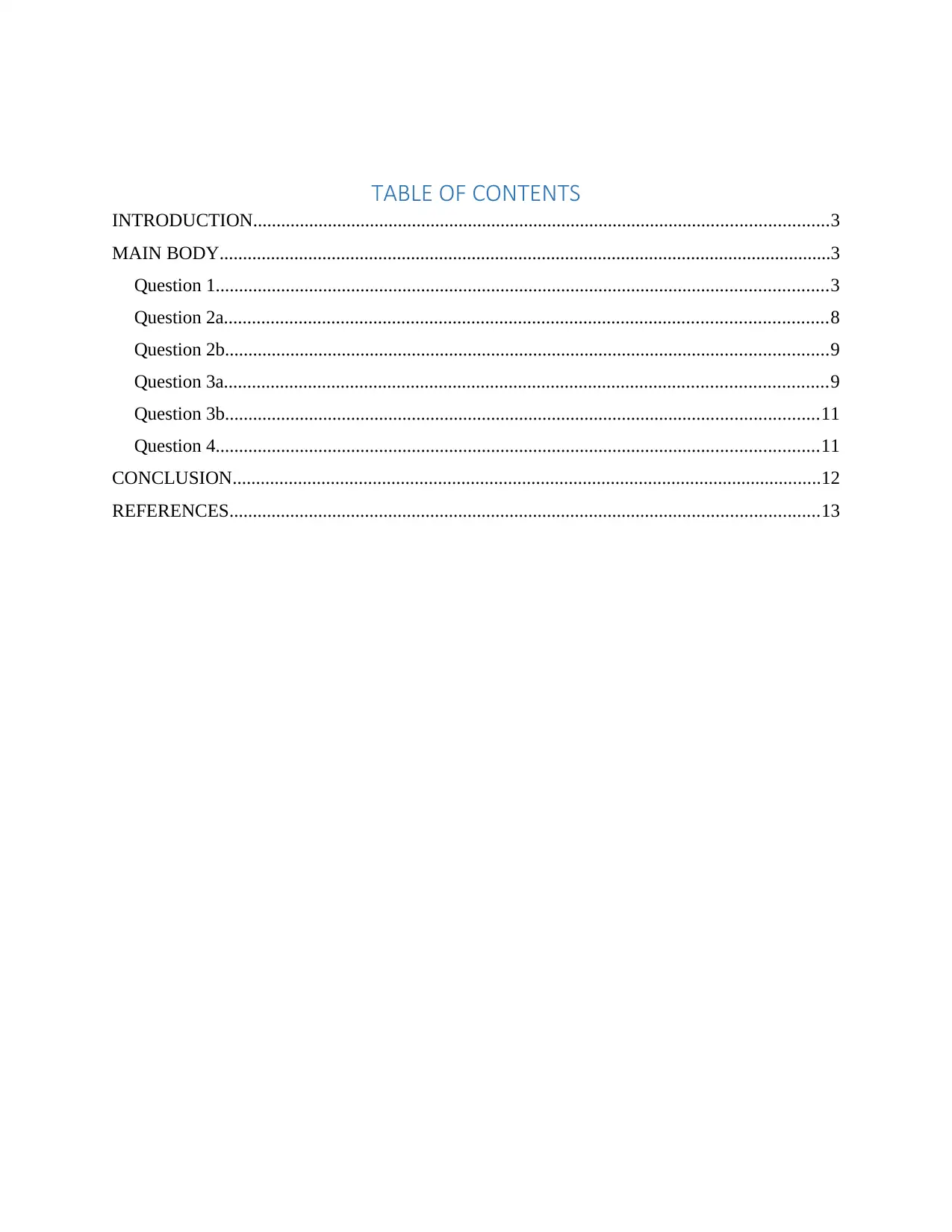
TABLE OF CONTENTS
INTRODUCTION...........................................................................................................................3
MAIN BODY...................................................................................................................................3
Question 1...................................................................................................................................3
Question 2a.................................................................................................................................8
Question 2b.................................................................................................................................9
Question 3a.................................................................................................................................9
Question 3b...............................................................................................................................11
Question 4.................................................................................................................................11
CONCLUSION..............................................................................................................................12
REFERENCES..............................................................................................................................13
INTRODUCTION...........................................................................................................................3
MAIN BODY...................................................................................................................................3
Question 1...................................................................................................................................3
Question 2a.................................................................................................................................8
Question 2b.................................................................................................................................9
Question 3a.................................................................................................................................9
Question 3b...............................................................................................................................11
Question 4.................................................................................................................................11
CONCLUSION..............................................................................................................................12
REFERENCES..............................................................................................................................13
⊘ This is a preview!⊘
Do you want full access?
Subscribe today to unlock all pages.

Trusted by 1+ million students worldwide
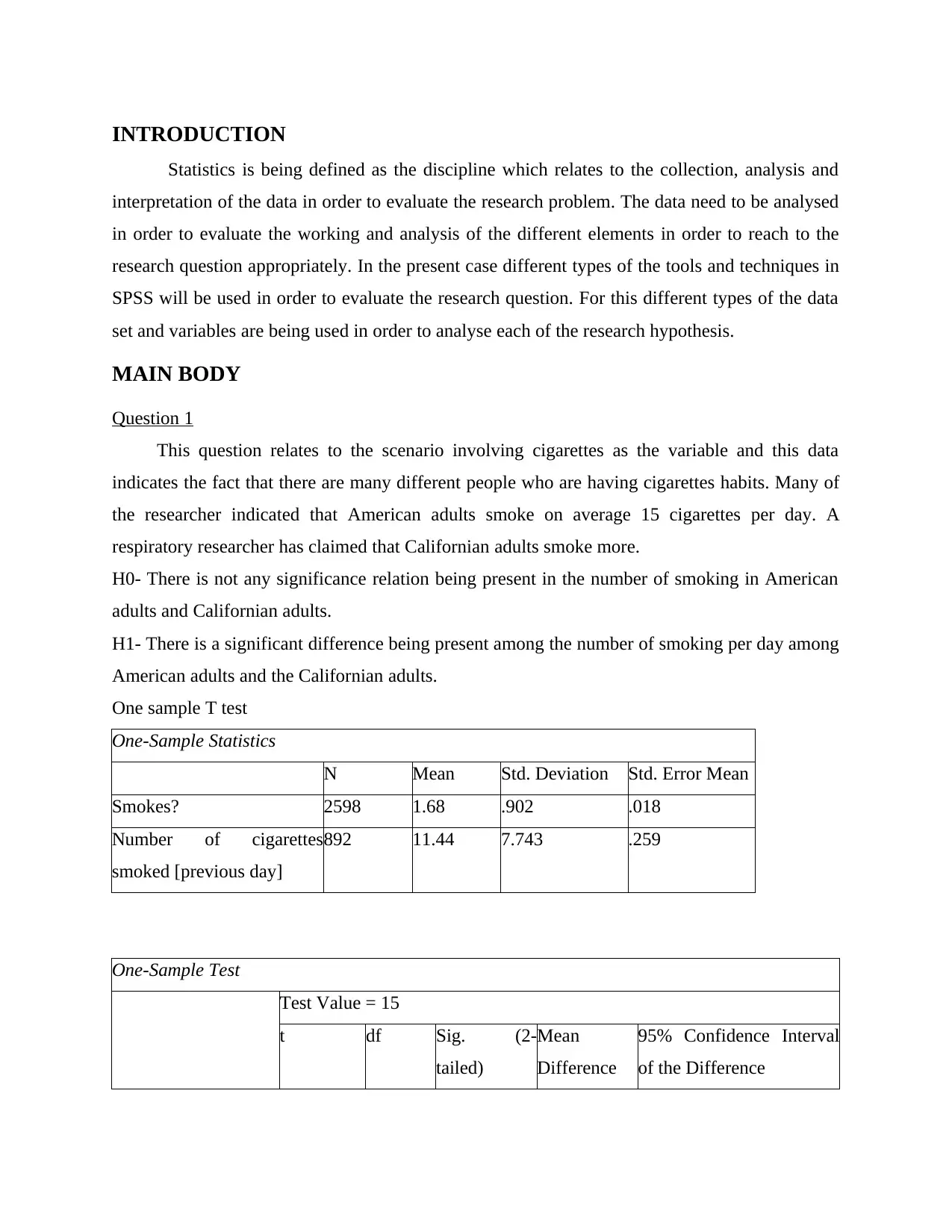
INTRODUCTION
Statistics is being defined as the discipline which relates to the collection, analysis and
interpretation of the data in order to evaluate the research problem. The data need to be analysed
in order to evaluate the working and analysis of the different elements in order to reach to the
research question appropriately. In the present case different types of the tools and techniques in
SPSS will be used in order to evaluate the research question. For this different types of the data
set and variables are being used in order to analyse each of the research hypothesis.
MAIN BODY
Question 1
This question relates to the scenario involving cigarettes as the variable and this data
indicates the fact that there are many different people who are having cigarettes habits. Many of
the researcher indicated that American adults smoke on average 15 cigarettes per day. A
respiratory researcher has claimed that Californian adults smoke more.
H0- There is not any significance relation being present in the number of smoking in American
adults and Californian adults.
H1- There is a significant difference being present among the number of smoking per day among
American adults and the Californian adults.
One sample T test
One-Sample Statistics
N Mean Std. Deviation Std. Error Mean
Smokes? 2598 1.68 .902 .018
Number of cigarettes
smoked [previous day]
892 11.44 7.743 .259
One-Sample Test
Test Value = 15
t df Sig. (2-
tailed)
Mean
Difference
95% Confidence Interval
of the Difference
Statistics is being defined as the discipline which relates to the collection, analysis and
interpretation of the data in order to evaluate the research problem. The data need to be analysed
in order to evaluate the working and analysis of the different elements in order to reach to the
research question appropriately. In the present case different types of the tools and techniques in
SPSS will be used in order to evaluate the research question. For this different types of the data
set and variables are being used in order to analyse each of the research hypothesis.
MAIN BODY
Question 1
This question relates to the scenario involving cigarettes as the variable and this data
indicates the fact that there are many different people who are having cigarettes habits. Many of
the researcher indicated that American adults smoke on average 15 cigarettes per day. A
respiratory researcher has claimed that Californian adults smoke more.
H0- There is not any significance relation being present in the number of smoking in American
adults and Californian adults.
H1- There is a significant difference being present among the number of smoking per day among
American adults and the Californian adults.
One sample T test
One-Sample Statistics
N Mean Std. Deviation Std. Error Mean
Smokes? 2598 1.68 .902 .018
Number of cigarettes
smoked [previous day]
892 11.44 7.743 .259
One-Sample Test
Test Value = 15
t df Sig. (2-
tailed)
Mean
Difference
95% Confidence Interval
of the Difference
Paraphrase This Document
Need a fresh take? Get an instant paraphrase of this document with our AI Paraphraser
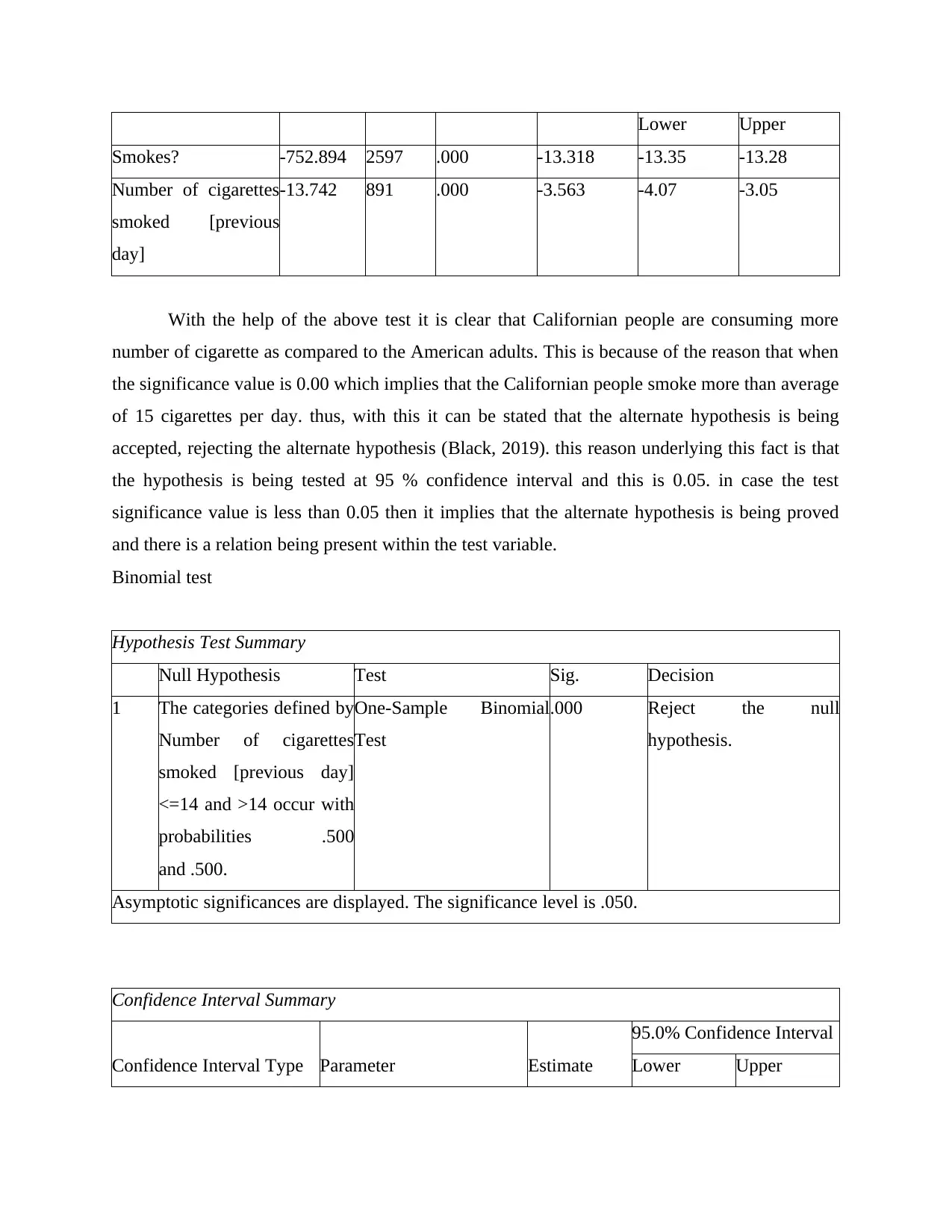
Lower Upper
Smokes? -752.894 2597 .000 -13.318 -13.35 -13.28
Number of cigarettes
smoked [previous
day]
-13.742 891 .000 -3.563 -4.07 -3.05
With the help of the above test it is clear that Californian people are consuming more
number of cigarette as compared to the American adults. This is because of the reason that when
the significance value is 0.00 which implies that the Californian people smoke more than average
of 15 cigarettes per day. thus, with this it can be stated that the alternate hypothesis is being
accepted, rejecting the alternate hypothesis (Black, 2019). this reason underlying this fact is that
the hypothesis is being tested at 95 % confidence interval and this is 0.05. in case the test
significance value is less than 0.05 then it implies that the alternate hypothesis is being proved
and there is a relation being present within the test variable.
Binomial test
Hypothesis Test Summary
Null Hypothesis Test Sig. Decision
1 The categories defined by
Number of cigarettes
smoked [previous day]
<=14 and >14 occur with
probabilities .500
and .500.
One-Sample Binomial
Test
.000 Reject the null
hypothesis.
Asymptotic significances are displayed. The significance level is .050.
Confidence Interval Summary
Confidence Interval Type Parameter Estimate
95.0% Confidence Interval
Lower Upper
Smokes? -752.894 2597 .000 -13.318 -13.35 -13.28
Number of cigarettes
smoked [previous
day]
-13.742 891 .000 -3.563 -4.07 -3.05
With the help of the above test it is clear that Californian people are consuming more
number of cigarette as compared to the American adults. This is because of the reason that when
the significance value is 0.00 which implies that the Californian people smoke more than average
of 15 cigarettes per day. thus, with this it can be stated that the alternate hypothesis is being
accepted, rejecting the alternate hypothesis (Black, 2019). this reason underlying this fact is that
the hypothesis is being tested at 95 % confidence interval and this is 0.05. in case the test
significance value is less than 0.05 then it implies that the alternate hypothesis is being proved
and there is a relation being present within the test variable.
Binomial test
Hypothesis Test Summary
Null Hypothesis Test Sig. Decision
1 The categories defined by
Number of cigarettes
smoked [previous day]
<=14 and >14 occur with
probabilities .500
and .500.
One-Sample Binomial
Test
.000 Reject the null
hypothesis.
Asymptotic significances are displayed. The significance level is .050.
Confidence Interval Summary
Confidence Interval Type Parameter Estimate
95.0% Confidence Interval
Lower Upper
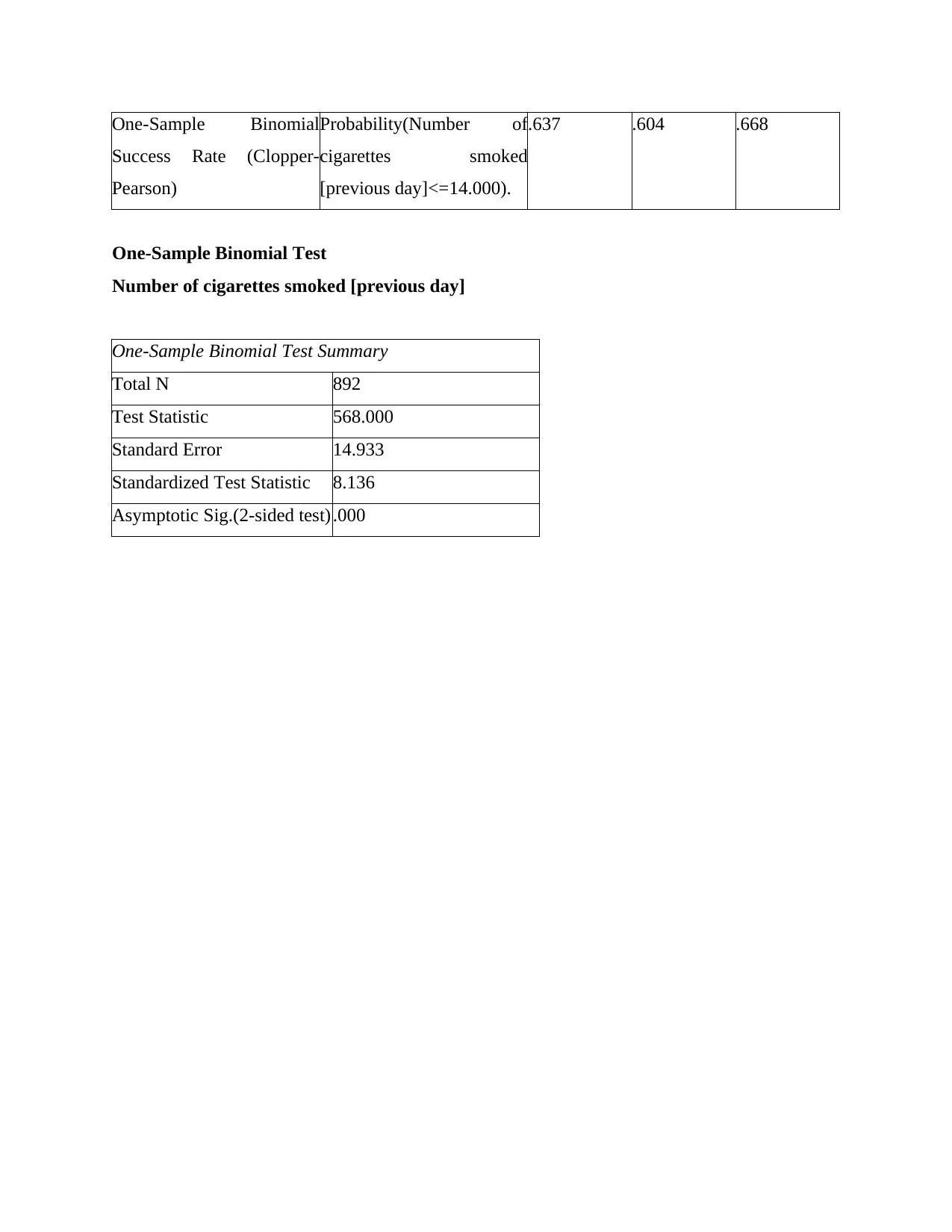
One-Sample Binomial
Success Rate (Clopper-
Pearson)
Probability(Number of
cigarettes smoked
[previous day]<=14.000).
.637 .604 .668
One-Sample Binomial Test
Number of cigarettes smoked [previous day]
One-Sample Binomial Test Summary
Total N 892
Test Statistic 568.000
Standard Error 14.933
Standardized Test Statistic 8.136
Asymptotic Sig.(2-sided test) .000
Success Rate (Clopper-
Pearson)
Probability(Number of
cigarettes smoked
[previous day]<=14.000).
.637 .604 .668
One-Sample Binomial Test
Number of cigarettes smoked [previous day]
One-Sample Binomial Test Summary
Total N 892
Test Statistic 568.000
Standard Error 14.933
Standardized Test Statistic 8.136
Asymptotic Sig.(2-sided test) .000
⊘ This is a preview!⊘
Do you want full access?
Subscribe today to unlock all pages.

Trusted by 1+ million students worldwide

Paraphrase This Document
Need a fresh take? Get an instant paraphrase of this document with our AI Paraphraser
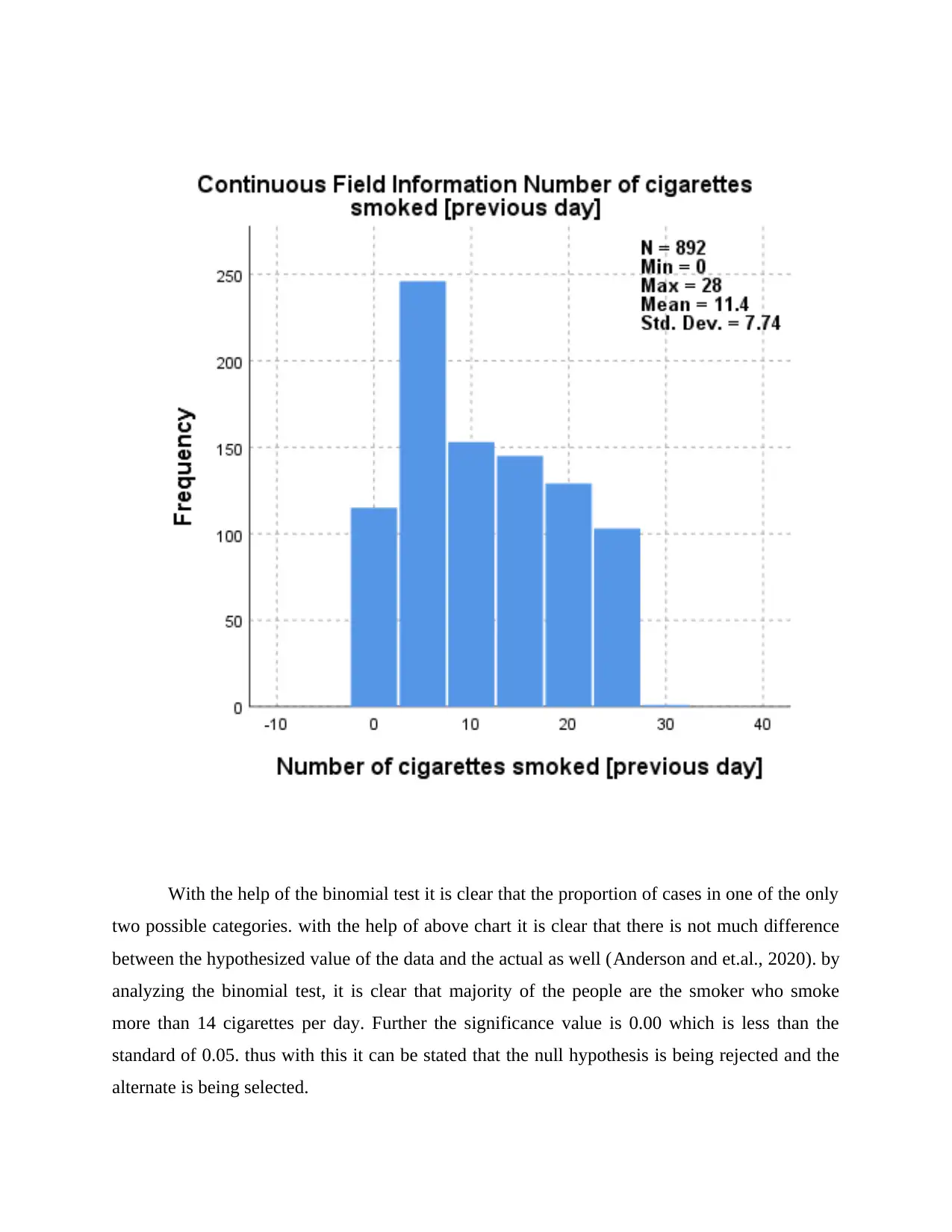
With the help of the binomial test it is clear that the proportion of cases in one of the only
two possible categories. with the help of above chart it is clear that there is not much difference
between the hypothesized value of the data and the actual as well (Anderson and et.al., 2020). by
analyzing the binomial test, it is clear that majority of the people are the smoker who smoke
more than 14 cigarettes per day. Further the significance value is 0.00 which is less than the
standard of 0.05. thus with this it can be stated that the null hypothesis is being rejected and the
alternate is being selected.
two possible categories. with the help of above chart it is clear that there is not much difference
between the hypothesized value of the data and the actual as well (Anderson and et.al., 2020). by
analyzing the binomial test, it is clear that majority of the people are the smoker who smoke
more than 14 cigarettes per day. Further the significance value is 0.00 which is less than the
standard of 0.05. thus with this it can be stated that the null hypothesis is being rejected and the
alternate is being selected.

Question 2a
In this question the variable related to the indication of psychological distress which is
being displayed by each of the participant. these scores of psychological distress is being
measured on the basis of the Kessler K6 screening scale. Within this scale participant are asked
six relating to different aspect that is how often they felt nervous, restless, worthless, hopeless,
depressed and ‘everything is an effort’ over the previous month.
H0- There is not any significant difference being present in psychological distress score on the
basis of the ager that is less than 40 and more than 40.
H1- There is a significant difference present in the distress score on basis of the age.
Group Statistics
Age Group N Mean
Std.
Deviation
Std. Error
Mean
Psychological Distress
Score [Kessler K6]
Less than 40 years 1387 4.92 4.272 .115
40 years or older 4871 3.20 3.680 .053
Independent Samples Test
Levene's
Test for
Equality of
Variances t-test for Equality of Means
F Sig. t df
Sig.
(2-
tailed
)
Mean
Differenc
e
Std.
Error
Differenc
e
95%
Confidence
Interval of
the
Difference
Lowe
r
Uppe
r
Psychologic
al Distress
Score
[Kessler K6]
Equal
variance
s
assumed
57.13
1
.00
0
14.82
7
6256 .000 1.724 .116 1.496 1.951
In this question the variable related to the indication of psychological distress which is
being displayed by each of the participant. these scores of psychological distress is being
measured on the basis of the Kessler K6 screening scale. Within this scale participant are asked
six relating to different aspect that is how often they felt nervous, restless, worthless, hopeless,
depressed and ‘everything is an effort’ over the previous month.
H0- There is not any significant difference being present in psychological distress score on the
basis of the ager that is less than 40 and more than 40.
H1- There is a significant difference present in the distress score on basis of the age.
Group Statistics
Age Group N Mean
Std.
Deviation
Std. Error
Mean
Psychological Distress
Score [Kessler K6]
Less than 40 years 1387 4.92 4.272 .115
40 years or older 4871 3.20 3.680 .053
Independent Samples Test
Levene's
Test for
Equality of
Variances t-test for Equality of Means
F Sig. t df
Sig.
(2-
tailed
)
Mean
Differenc
e
Std.
Error
Differenc
e
95%
Confidence
Interval of
the
Difference
Lowe
r
Uppe
r
Psychologic
al Distress
Score
[Kessler K6]
Equal
variance
s
assumed
57.13
1
.00
0
14.82
7
6256 .000 1.724 .116 1.496 1.951
⊘ This is a preview!⊘
Do you want full access?
Subscribe today to unlock all pages.

Trusted by 1+ million students worldwide
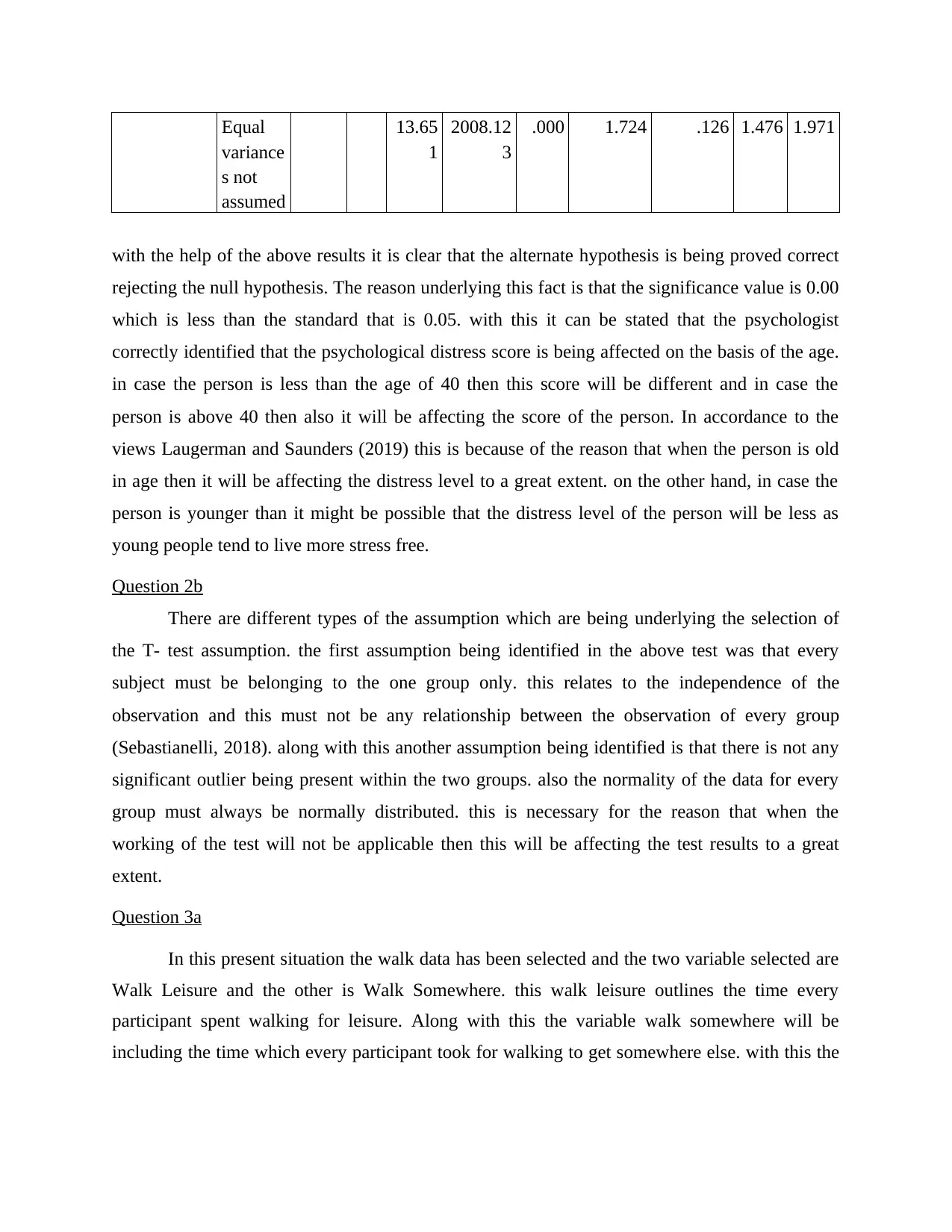
Equal
variance
s not
assumed
13.65
1
2008.12
3
.000 1.724 .126 1.476 1.971
with the help of the above results it is clear that the alternate hypothesis is being proved correct
rejecting the null hypothesis. The reason underlying this fact is that the significance value is 0.00
which is less than the standard that is 0.05. with this it can be stated that the psychologist
correctly identified that the psychological distress score is being affected on the basis of the age.
in case the person is less than the age of 40 then this score will be different and in case the
person is above 40 then also it will be affecting the score of the person. In accordance to the
views Laugerman and Saunders (2019) this is because of the reason that when the person is old
in age then it will be affecting the distress level to a great extent. on the other hand, in case the
person is younger than it might be possible that the distress level of the person will be less as
young people tend to live more stress free.
Question 2b
There are different types of the assumption which are being underlying the selection of
the T- test assumption. the first assumption being identified in the above test was that every
subject must be belonging to the one group only. this relates to the independence of the
observation and this must not be any relationship between the observation of every group
(Sebastianelli, 2018). along with this another assumption being identified is that there is not any
significant outlier being present within the two groups. also the normality of the data for every
group must always be normally distributed. this is necessary for the reason that when the
working of the test will not be applicable then this will be affecting the test results to a great
extent.
Question 3a
In this present situation the walk data has been selected and the two variable selected are
Walk Leisure and the other is Walk Somewhere. this walk leisure outlines the time every
participant spent walking for leisure. Along with this the variable walk somewhere will be
including the time which every participant took for walking to get somewhere else. with this the
variance
s not
assumed
13.65
1
2008.12
3
.000 1.724 .126 1.476 1.971
with the help of the above results it is clear that the alternate hypothesis is being proved correct
rejecting the null hypothesis. The reason underlying this fact is that the significance value is 0.00
which is less than the standard that is 0.05. with this it can be stated that the psychologist
correctly identified that the psychological distress score is being affected on the basis of the age.
in case the person is less than the age of 40 then this score will be different and in case the
person is above 40 then also it will be affecting the score of the person. In accordance to the
views Laugerman and Saunders (2019) this is because of the reason that when the person is old
in age then it will be affecting the distress level to a great extent. on the other hand, in case the
person is younger than it might be possible that the distress level of the person will be less as
young people tend to live more stress free.
Question 2b
There are different types of the assumption which are being underlying the selection of
the T- test assumption. the first assumption being identified in the above test was that every
subject must be belonging to the one group only. this relates to the independence of the
observation and this must not be any relationship between the observation of every group
(Sebastianelli, 2018). along with this another assumption being identified is that there is not any
significant outlier being present within the two groups. also the normality of the data for every
group must always be normally distributed. this is necessary for the reason that when the
working of the test will not be applicable then this will be affecting the test results to a great
extent.
Question 3a
In this present situation the walk data has been selected and the two variable selected are
Walk Leisure and the other is Walk Somewhere. this walk leisure outlines the time every
participant spent walking for leisure. Along with this the variable walk somewhere will be
including the time which every participant took for walking to get somewhere else. with this the
Paraphrase This Document
Need a fresh take? Get an instant paraphrase of this document with our AI Paraphraser

major research question is that the whether there is a difference between the time spent for
leisure and the time spent for the walking purposefully.
H0- There is not any significant relation being present among the time spent walking for leisure
and the time spent for walking with a purpose.
H1- There is a significant difference being present between the time spent for walking for leisure
and the time spent for walking with a purpose.
Paired Samples Statistics
Mean N Std. Deviation
Std. Error
Mean
Pair 1 Time walked for leisure
[mins in previous week]
36.17 2166 41.961 .902
Time walked 'to get
somewhere' [mins in
previous week]
31.91 2166 44.202 .950
Paired Samples Correlations
N Correlation Sig.
Pair 1 Time walked for leisure
[mins in previous week] &
Time walked 'to get
somewhere' [mins in
previous week]
2166 .231 .000
Paired Samples Test
Paired Differences
t df
Sig. (2-
tailed)Mean
Std.
Deviation
Std.
Error
Mean
95% Confidence
Interval of the
Difference
Lower Upper
leisure and the time spent for the walking purposefully.
H0- There is not any significant relation being present among the time spent walking for leisure
and the time spent for walking with a purpose.
H1- There is a significant difference being present between the time spent for walking for leisure
and the time spent for walking with a purpose.
Paired Samples Statistics
Mean N Std. Deviation
Std. Error
Mean
Pair 1 Time walked for leisure
[mins in previous week]
36.17 2166 41.961 .902
Time walked 'to get
somewhere' [mins in
previous week]
31.91 2166 44.202 .950
Paired Samples Correlations
N Correlation Sig.
Pair 1 Time walked for leisure
[mins in previous week] &
Time walked 'to get
somewhere' [mins in
previous week]
2166 .231 .000
Paired Samples Test
Paired Differences
t df
Sig. (2-
tailed)Mean
Std.
Deviation
Std.
Error
Mean
95% Confidence
Interval of the
Difference
Lower Upper
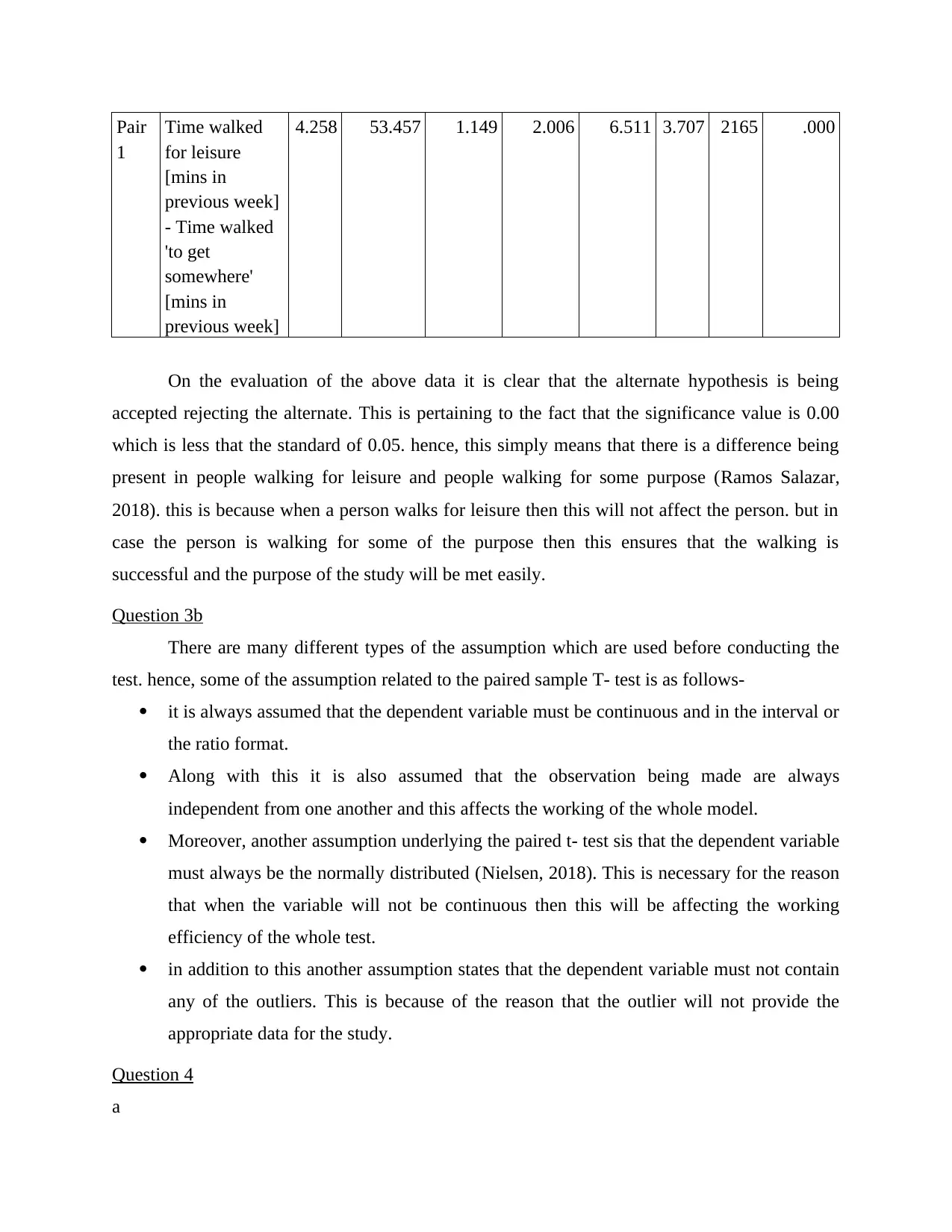
Pair
1
Time walked
for leisure
[mins in
previous week]
- Time walked
'to get
somewhere'
[mins in
previous week]
4.258 53.457 1.149 2.006 6.511 3.707 2165 .000
On the evaluation of the above data it is clear that the alternate hypothesis is being
accepted rejecting the alternate. This is pertaining to the fact that the significance value is 0.00
which is less that the standard of 0.05. hence, this simply means that there is a difference being
present in people walking for leisure and people walking for some purpose (Ramos Salazar,
2018). this is because when a person walks for leisure then this will not affect the person. but in
case the person is walking for some of the purpose then this ensures that the walking is
successful and the purpose of the study will be met easily.
Question 3b
There are many different types of the assumption which are used before conducting the
test. hence, some of the assumption related to the paired sample T- test is as follows-
it is always assumed that the dependent variable must be continuous and in the interval or
the ratio format.
Along with this it is also assumed that the observation being made are always
independent from one another and this affects the working of the whole model.
Moreover, another assumption underlying the paired t- test sis that the dependent variable
must always be the normally distributed (Nielsen, 2018). This is necessary for the reason
that when the variable will not be continuous then this will be affecting the working
efficiency of the whole test.
in addition to this another assumption states that the dependent variable must not contain
any of the outliers. This is because of the reason that the outlier will not provide the
appropriate data for the study.
Question 4
a
1
Time walked
for leisure
[mins in
previous week]
- Time walked
'to get
somewhere'
[mins in
previous week]
4.258 53.457 1.149 2.006 6.511 3.707 2165 .000
On the evaluation of the above data it is clear that the alternate hypothesis is being
accepted rejecting the alternate. This is pertaining to the fact that the significance value is 0.00
which is less that the standard of 0.05. hence, this simply means that there is a difference being
present in people walking for leisure and people walking for some purpose (Ramos Salazar,
2018). this is because when a person walks for leisure then this will not affect the person. but in
case the person is walking for some of the purpose then this ensures that the walking is
successful and the purpose of the study will be met easily.
Question 3b
There are many different types of the assumption which are used before conducting the
test. hence, some of the assumption related to the paired sample T- test is as follows-
it is always assumed that the dependent variable must be continuous and in the interval or
the ratio format.
Along with this it is also assumed that the observation being made are always
independent from one another and this affects the working of the whole model.
Moreover, another assumption underlying the paired t- test sis that the dependent variable
must always be the normally distributed (Nielsen, 2018). This is necessary for the reason
that when the variable will not be continuous then this will be affecting the working
efficiency of the whole test.
in addition to this another assumption states that the dependent variable must not contain
any of the outliers. This is because of the reason that the outlier will not provide the
appropriate data for the study.
Question 4
a
⊘ This is a preview!⊘
Do you want full access?
Subscribe today to unlock all pages.

Trusted by 1+ million students worldwide

With respect to the present case provided that is for analysing the difference between
Australian consumption of ice-cream and the American consumption of ice- cream is present or
not. hence, for the testing of this hypothesis the use of independent sample T- test will be applied
(Salazar, 2019). the reason underlying this fact is that this test is being used in order to analyse
the statistical difference between the mean of two group. in this present case the two groups
present are American consumer and the Australian consumers.
b
The population being taken within the study will be the Australian consumers as the ice-
cream consumption need to be analysed so that the conclusion can be drawn from the data. The
average consumption of American ice cream is being present and now for analysing the
difference there is a need to analyse and gather the Australian ice- cream consumption data
(Nguyen-Newby and Fraser, 2021). hence, when the data will be gathered then the different test
will be applied and conclusion can be drawn.
c
In accordance to conclusion made by the dietician it is not correct. this is pertaining to the
fact that when the significance value is 0.143 which is more than 0.05 and this implies that there
is not any significant difference being present in the Australian consumption trend and the
American ice cream trend.
d
The validity of the conclusion made by the dietician is not correct. This is because of the
reason that the hypothesis is not being proved correct because the significance value is more than
the standard. the correct conclusion for the study based on significance value of 0.143 is that the
null hypothesis is being accepted and there is not any significant difference being present in the
Australian consumption patter.
CONCLUSION
In the end it is concluded that statistics includes the use of different types of the tools and
techniques which are assistive in managing the working and solving the research problem easily.
with the above analysis it is clear that there are different types of the tools and test like one
sample T- test, paired sample T- test and many other different tools.
Australian consumption of ice-cream and the American consumption of ice- cream is present or
not. hence, for the testing of this hypothesis the use of independent sample T- test will be applied
(Salazar, 2019). the reason underlying this fact is that this test is being used in order to analyse
the statistical difference between the mean of two group. in this present case the two groups
present are American consumer and the Australian consumers.
b
The population being taken within the study will be the Australian consumers as the ice-
cream consumption need to be analysed so that the conclusion can be drawn from the data. The
average consumption of American ice cream is being present and now for analysing the
difference there is a need to analyse and gather the Australian ice- cream consumption data
(Nguyen-Newby and Fraser, 2021). hence, when the data will be gathered then the different test
will be applied and conclusion can be drawn.
c
In accordance to conclusion made by the dietician it is not correct. this is pertaining to the
fact that when the significance value is 0.143 which is more than 0.05 and this implies that there
is not any significant difference being present in the Australian consumption trend and the
American ice cream trend.
d
The validity of the conclusion made by the dietician is not correct. This is because of the
reason that the hypothesis is not being proved correct because the significance value is more than
the standard. the correct conclusion for the study based on significance value of 0.143 is that the
null hypothesis is being accepted and there is not any significant difference being present in the
Australian consumption patter.
CONCLUSION
In the end it is concluded that statistics includes the use of different types of the tools and
techniques which are assistive in managing the working and solving the research problem easily.
with the above analysis it is clear that there are different types of the tools and test like one
sample T- test, paired sample T- test and many other different tools.
Paraphrase This Document
Need a fresh take? Get an instant paraphrase of this document with our AI Paraphraser

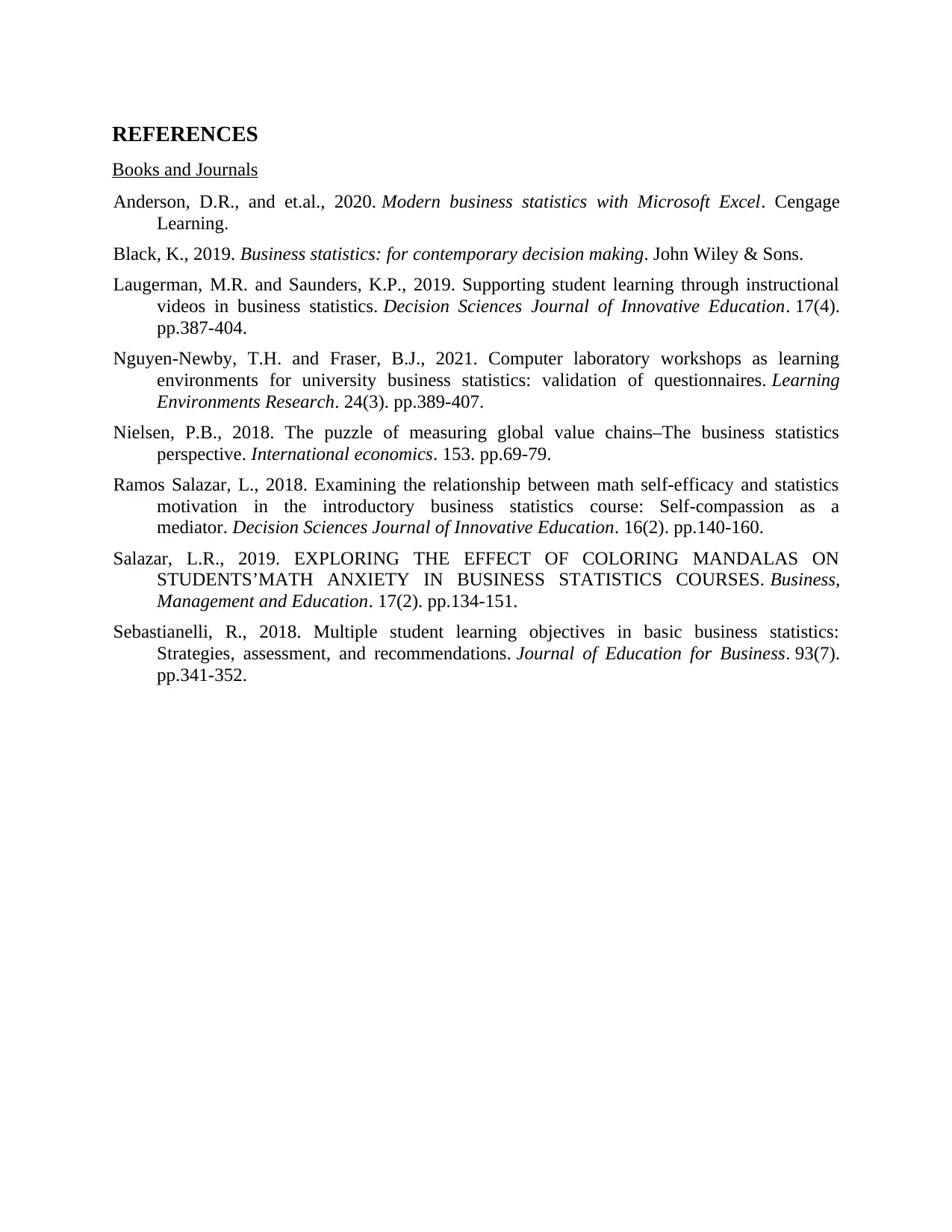
REFERENCES
Books and Journals
Anderson, D.R., and et.al., 2020. Modern business statistics with Microsoft Excel. Cengage
Learning.
Black, K., 2019. Business statistics: for contemporary decision making. John Wiley & Sons.
Laugerman, M.R. and Saunders, K.P., 2019. Supporting student learning through instructional
videos in business statistics. Decision Sciences Journal of Innovative Education. 17(4).
pp.387-404.
Nguyen-Newby, T.H. and Fraser, B.J., 2021. Computer laboratory workshops as learning
environments for university business statistics: validation of questionnaires. Learning
Environments Research. 24(3). pp.389-407.
Nielsen, P.B., 2018. The puzzle of measuring global value chains–The business statistics
perspective. International economics. 153. pp.69-79.
Ramos Salazar, L., 2018. Examining the relationship between math self‐efficacy and statistics
motivation in the introductory business statistics course: Self‐compassion as a
mediator. Decision Sciences Journal of Innovative Education. 16(2). pp.140-160.
Salazar, L.R., 2019. EXPLORING THE EFFECT OF COLORING MANDALAS ON
STUDENTS’MATH ANXIETY IN BUSINESS STATISTICS COURSES. Business,
Management and Education. 17(2). pp.134-151.
Sebastianelli, R., 2018. Multiple student learning objectives in basic business statistics:
Strategies, assessment, and recommendations. Journal of Education for Business. 93(7).
pp.341-352.
Books and Journals
Anderson, D.R., and et.al., 2020. Modern business statistics with Microsoft Excel. Cengage
Learning.
Black, K., 2019. Business statistics: for contemporary decision making. John Wiley & Sons.
Laugerman, M.R. and Saunders, K.P., 2019. Supporting student learning through instructional
videos in business statistics. Decision Sciences Journal of Innovative Education. 17(4).
pp.387-404.
Nguyen-Newby, T.H. and Fraser, B.J., 2021. Computer laboratory workshops as learning
environments for university business statistics: validation of questionnaires. Learning
Environments Research. 24(3). pp.389-407.
Nielsen, P.B., 2018. The puzzle of measuring global value chains–The business statistics
perspective. International economics. 153. pp.69-79.
Ramos Salazar, L., 2018. Examining the relationship between math self‐efficacy and statistics
motivation in the introductory business statistics course: Self‐compassion as a
mediator. Decision Sciences Journal of Innovative Education. 16(2). pp.140-160.
Salazar, L.R., 2019. EXPLORING THE EFFECT OF COLORING MANDALAS ON
STUDENTS’MATH ANXIETY IN BUSINESS STATISTICS COURSES. Business,
Management and Education. 17(2). pp.134-151.
Sebastianelli, R., 2018. Multiple student learning objectives in basic business statistics:
Strategies, assessment, and recommendations. Journal of Education for Business. 93(7).
pp.341-352.
⊘ This is a preview!⊘
Do you want full access?
Subscribe today to unlock all pages.

Trusted by 1+ million students worldwide
1 out of 15
Related Documents
Your All-in-One AI-Powered Toolkit for Academic Success.
+13062052269
info@desklib.com
Available 24*7 on WhatsApp / Email
![[object Object]](/_next/static/media/star-bottom.7253800d.svg)
Unlock your academic potential
© 2024 | Zucol Services PVT LTD | All rights reserved.





